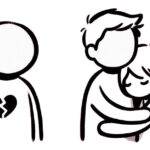Attachment styles are patterns of connection that shape our relationships and emotional bonds, a concept psychologists have extensively studied. There are four main styles of attachment, namely secure, which comes with confidence, open communication, and trust; insecure-anxious, riddled with worries that can cloud our interactions; and insecure-avoidant, which may lead us to retreat from closeness; lastly, disorganised attachment, which is a conflict between the need for closeness and the fear or mistrust.
Table of Contents
Defining secure attachment
Securely attached people often have a strong sense of self-worth and an expectation that others will be supportive when needed (approximately 60% of people). They approach life with a generally positive outlook and are good at managing stress and challenges. They tend to seek support when needed, communicate openly, and are comfortable with interdependence in relationships.
Avoidant and anxious attachment style
Both avoidant and anxious attachment styles are categorised as “insecure attachment”, although not pathological. Meaning both children and later adults, may display these attachment styles but overall can manage their relationships well.
Anxious attachment (anxious-preoccupied)
Anxious attachment is a type of insecure attachment style (approximately 20% of people). People with anxious attachment styles repeatedly worry about the availability and responsiveness of others. They may seek or even provoke reassurance and validation, continually feeling insecure about their relationships. They often have an intense need for closeness and fear of abandonment, which can lead to clinginess in relationships, sometimes pushing partners away.
Avoidant attachment (anxious-avoidant, resistant, anxious-resistant)
Avoidant attachment is another type of insecure attachment style (approximately 20% of people). It is often referred to as an anxious-avoidant or resistant attachment style.
Avoidantly attached individuals, maintain emotional distance “at an arm’s length”, and value independence over intimacy. They often do not trust others’ intentions and may avoid close romantic relationships or even friendships altogether. They are reluctant to rely on others and prefer to handle issues alone, but having great difficulty expressing emotions or needs.
Disorganised attachment style
Disorganized attachment style, a type of insecure attachment, is characterised by contradictory or disoriented behaviour in relationships (less than 10% of people). Unlike avoidant and anxious attachment styles, disorganised attachment is often a sign of other mental health problems.
People with disorganised attachment styles show parts of both anxious and avoidant attachment styles, which is often confusing for both the person and others around them. They may struggle to understand when the relationship feels “too close”, leading to pushing others away, or a needy attachment, eliciting care and validation from others.
Disorganised attachment typically stems from early childhood experiences, often involving inconsistent or frightening caregiving. This can create a sense of unpredictability and fear in relationships, as the child learns to associate closeness with both comfort and danger. Over time, this can manifest as a lack of coherent strategy for managing emotional closeness or distance in adult relationships.
Individuals with this attachment style may experience intense emotional swings, oscillating between seeking connection and withdrawing from it. This inconsistency can make it difficult for them to form stable, trusting relationships. They may also struggle with self-regulation, finding it hard to manage their emotions in ways that feel safe or constructive.
Disorganised attachment is frequently linked to trauma, particularly in childhood. Experiences such as abuse, neglect, or exposure to a caregiver’s unresolved trauma can contribute to its development. This attachment style is often associated with higher rates of mental health challenges, including anxiety, and depression.
In relationships, people with disorganised attachment may exhibit behaviours that seem contradictory or confusing. For example, they might express a strong desire for intimacy but then act in ways that sabotage it, such as becoming overly critical or emotionally distant. This can create a cycle of frustration and misunderstanding for both partners.
Therapeutic interventions, such as DBT, trauma-focused CBT therapy or attachment-based therapy, can be helpful for individuals with disorganised attachment. These approaches aim to create a safe space for exploring past experiences, developing healthier relationship patterns, and building a more secure sense of self.
Where do insecure attachment styles come from?
Insecure attachment (either anxious or avoidant) often develops based on early interactions with parents, if they fail to provide stable emotional support, hindering the development of coping mechanisms. This can lead to deeply ingrained patterns of either needing too much validation or avoiding caregivers (or partners later).
Disorganised attachment is often a result of difficult childhood experiences with abusive caregivers. This may lead to a lack of a coherent attachment strategy, resulting in behaviours such as fearfulness, confusion, and disorientation in relationships.
These learned behaviours become particularly problematic during intense, prolonged stress, where active support-seeking is necessary. When this happens, attachment insecurity can intensify, affecting not only the individual’s mental and physical health but also negatively impacting their close relationships.
Avoidants shut down emotions during stress
Individuals with avoidant attachment tend to suppress emotions that might activate their attachment needs, such as fear, anxiety, anger, sadness, shame, guilt, and distress. They try to maintain emotional distance and independence, even in the face of potential threats to their relationships, like rejection or separation – this behaviour was likely adaptive when they were children and needed to deal with the painful emotions of parents not being available.
Avoidants may not remember stressful emotions well
Avoidant individuals often have difficulty recalling sad or anxious memories and tend to perceive the feelings associated with these memories as less intense. This suggests a defensive mechanism at work, aiming to block out negative emotions.
However, suppressing emotions can prevent the integration of these emotional experiences into their cognitive and affective frameworks, leading to less effective social behaviour and information processing. In other words, shutting down and not managing emotions actively leads to long-lasting problems and repeating patterns of avoidance.
Avoiding (blocking out) emotions is too hard and may fail
When it comes to suppressing thoughts, avoidant individuals generally show a greater ability to suppress thoughts of loss or separation, which is reflected in their lower physiological responses during such tasks.
However, under pressure (for instance, when tired, stressed, or have a lot on), their ability to suppress negative thoughts fades, and they can become overwhelmed by the emotions they usually keep at bay.
Research refers to this as avoidants’ defence mechanisms are fragile and often collapse under pressure.
Anxious over-activation of emotions during stress
Conversely, those with anxious attachment often amplify negative emotions, viewing them as aligned with their goals of seeking closeness and activating attachment needs.
People with anxious attachment styles often overestimate threats and their own vulnerability to gain attention and support from their friends and partners – a behaviour that was helpful in childhood when parents were too busy but unhelpful as adults.
This exaggeration of emotional states and perceived helplessness can sometimes draw the care they seek, but it may also perpetuate a cycle of dependency and anxiety in their relationships.
Anxious individuals tend to have quick access to stressful memories and experience the emotions as very intense, indicating a heightened sensitivity to negative emotional states.
Because of this, they struggle with thought suppression, often experiencing more frequent thoughts of loss and higher physiological arousal, such as shaking, heartbeat, and sweating, which can exacerbate their distress.
Anxious to secure attachment
It is natural to feel anxious or insecure in relationships sometimes, based on our early childhood experiences. However, attachment styles are not fixed or permanent. Through therapy, such as CBT therapy, focusing on attachment patterns, it is very possible to develop a more secure way of connecting in relationships.
By exploring your past experiences and how they shaped your attachment style, you can gain insight into the root of your anxieties or insecurities. You can learn what is triggering for you, how to manage your thoughts around these better, and how to relate to others in more helpful ways.
With this understanding, you can then work on developing healthier ways of relating, improving communication skills, building self-esteem, and setting healthy boundaries. You can reshape patterns of anxious or clingy behaviours, jealousy, or a fear of abandonment.
Is my boyfriend/girlfriend anxious or avoidant?
To have an idea of whether your partner is anxious or avoidant, observe their behaviour in the relationship. If they often seek reassurance, worry about your availability, and are sensitive to any signs of distancing, they may have an anxious attachment style.
However, if they (over)value independence, prefer to keep an emotional distance, and are uncomfortable with intimacy, they are more likely to have an avoidant attachment style.
How do avoidants act when triggered?
Avoidants, when triggered, may withdraw, seek solitude, or deal with issues on their own rather than seeking support. They might also minimise the importance of the trigger or distract themselves with work or other activities.
How do anxious avoidants act in relationships?
Anxious avoidants (another phrase for avoidant style), can sometimes display a mix of behaviours: not such fearing intimacy, but craving closeness at the same time. They might switch between wanting affection and then pushing their partner away, sometimes creating a push-pull dynamic in the relationship.
How to tell if your partner has an avoidant attachment style?
To tell if your partner has an avoidant attachment style, look for signs like discomfort with too much closeness, a strong preference for solitude, and difficulty discussing emotions or vulnerabilities.
How do avoidants act when they are in love? How do avoidants show they love you?
When in love, avoidants may struggle to express their feelings openly and might show love through actions rather than words. They may also set boundaries to maintain their sense of independence. Sometimes they might seek closeness, which scares them and suddenly pull back.
What are anxious attachment styles attracted to?
Anxious-avoidants (just another phrase for avoidant style) are often attracted to partners who validate their worth and provide the security they crave, yet they may also be drawn to relationships that reinforce their fears of abandonment or rejection. When their rejection sensitivity is triggered, they might experience a range of powerful emotions, which can create an unhelpful, self-reinforcing cycle.
When should you leave an avoidant partner?
If you feel the distance they keep after a longer term of dating is too much for you, raise it as soon as you can so you can work something out. However, if you feel the progress is too slow for you, or you lack the closeness and intimacy you want, it’s time to think about the future of the relationship.
You might want to consider leaving an avoidant partner if the relationship consistently lacks emotional connection, your needs for intimacy are not being met, and there’s no willingness from the avoidant partner to work on these issues.
What hurts an avoidant the most?
What hurts an avoidant the most is feeling rushed to build intimacy, being pressured to open up emotionally, or being pushed into situations that require vulnerability and dependence on others.
Do avoidants know they hurt you?
Avoidants may not always be aware that they hurt you, as their coping mechanisms are deeply ingrained and often unconscious responses to perceived threats to their independence. As we discussed above, they shut out emotions and often cannot remember emotionally charged situations too well.
Don’t be afraid to raise these with your partner when things calm down, so they can be aware and work on this, if needed.
Do avoidants expect you to chase them?
Avoidants typically do not expect you to chase them; they value self-sufficiency and might interpret chasing as a violation of their boundaries.
For that matter, it’s usually better not to “chase” anyone – if they like you back and they are able to show it, you are off to a good start. If not, maybe it is better to find someone who is ready to be with you.
Are narcissists anxious or avoidant?
Narcissism is not directly linked to attachment styles; however, narcissists can display traits similar to both anxious and avoidant styles, such as a need for validation or a lack of empathy and emotional availability.
How do you reassure an avoidant partner? How do you make an avoidant feel safe?
To reassure an avoidant partner, respect their need for space, be patient, and communicate calmly and clearly without pressuring them for immediate closeness or emotional responses.
Please note that this blog post by Personal Psychology, psychologists in North Sydney is not intended to provide professional advice. If you or someone you know is experiencing mental health difficulties, it is important to seek help from a qualified healthcare professional.





